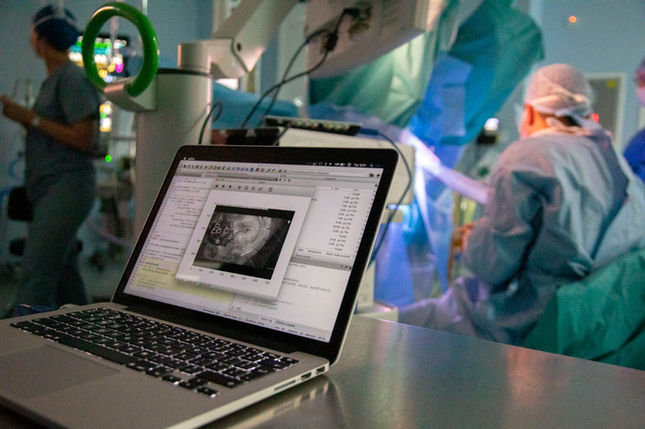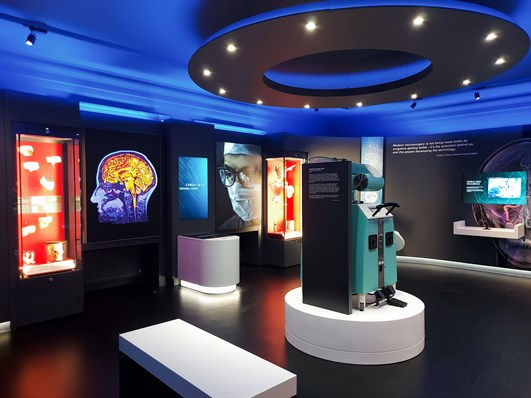
BODY VOYAGER
Project Artist - Body Voyager
Surgeon's Hall Museum, Edinburgh
2020-2021
In 2019 I was approached by the Surgeon's Hall Museum to produce paintings for a new wing of the museum exploring the 'Future of Surgery'.
The museum, in the same space as the Royal College of Surgeon's of Edinburgh, already boasted an amazingly interesting and eclectic display, including the History of Surgery, History of Dentistry, and the Pathology Museum. But to bring it up to the 21st Century and beyond, they wanted to show the Future of Surgery with an entirely new wing called 'Body Voyager'.
Surgeon's Hall Museum, Edinburgh
Body Voyager was going to explore the rise of the computerised and robotic technologies used within medicine... Something that for many is quite jarring. During my research phase I did a lot of community interviews, many were in the belief that robots would replace surgeons, and there was a level of distrust associated with this. I was brought on to visually explain and humanise these new technologies, specifically the Da Vinci robot.
Research
Due to the project coinciding with the outbreak and spread of Covid-19
(March 2020), my research was all done online. I was used to working using
online sources, however not being able to see these technologies in action in
the operating room presented itself with its own challenges. Using a range of
sources including information provided by the museum, surgical staff, local
hospitals and self-initiated study, I started by researching Intuitive, an
American company that develops, manufactures and markets robotic
products for surgical and clinical purposes. Specifically, the development of
equipment that would allow for minimally-invasive procedures, all done
through the newest pioneering equipment, the Da Vinci robot.
The Da Vinci Robot and Surgical Console
Instantly drawn to it by its name, Da Vinci, it felt like a coming together of
art and science, of the original artist-scientist, Leonardo Da Vinci.
The Surgeon's Hall Museum, wanted me to come to my own conclusions, as
an intermediary between surgical world and general public to pin-point
where I thought the key misunderstandings, and thus key points of focus for
us, may lie.
Da Vinci arm attachment examples
Presentation of Findings
What I found was that the Da Vinci robot is an extremely exciting new tool. The arms are controlled by the surgeon from a terminal which can even be in an entirely different room to the patient. The surgeon controls the arms of the Da Vinci, which can have any number of precision instruments attached. The movements made by the surgeon in the console, are mimicked by the Da Vinci, however each movement is done so at a fraction of the size. This allows for greater precision. While it also has a fail-safe, so any drastic movements made by the surgeon, the robot will not copy, so there is minimal error. Greater accuracy, at a much smaller scale, with less chance of error, allowing for a much quicker recovery time? the Da Vinci feels like a new technology that's too good NOT to use.
However within my research I realised some of my own preconceived hesitancies were put to bed. It was these that I presented to the Surgeon's Hall Museum, and thus I proposed three paintings:
1. The Surgeon-Person
I wanted to ensure that the surgeon remained central to a viewer-visitor's notions of robotic surgery. I felt a piece was needed to put the surgeon back into view. Surgeon's quite often take on this faceless identity, they are seen just before and just after an operation but not much more. I wanted to ensure that emphasis was placed upon the surgeon, as a person, as an individual, who has trained to an extraordinarily high level for many years to be operating.
2. Robot as Extension
Rather than a replacement of the surgeon, the robot is another tool the surgeon uses. Just as the scalpel seemingly becomes an extension of the surgeon's arm, the robot too allows for the surgeon to reach and act in ways that would otherwise not be possible. The robot allows for all this, but it is ultimately the surgeon who is in control.
3. Holistic View of the Robotic Surgical Theatre
It is not just patient and surgeon in the operating theatre. An entire team is present, all trained, practiced and there for the benefit of one person, the patient. I wanted to give voice to those that often get forgotten by the general public. providing a more holistic view of the theatre, and to provide a very clear view of who is there, what they're doing.
Creation of work
Finished Pieces
1. Surgeon-Person, oil on 40 x 50cm board
2. Robot as Extension, oil on 50 x 70 cm board
3. Robotic Theatre Panorama, oil on 80 x 220 cm board
to read about the opening night!!
Publications
https://museum.rcsed.ac.uk/body-voyager
https://www.facebook.com/watch/?v=1009840356495141

































